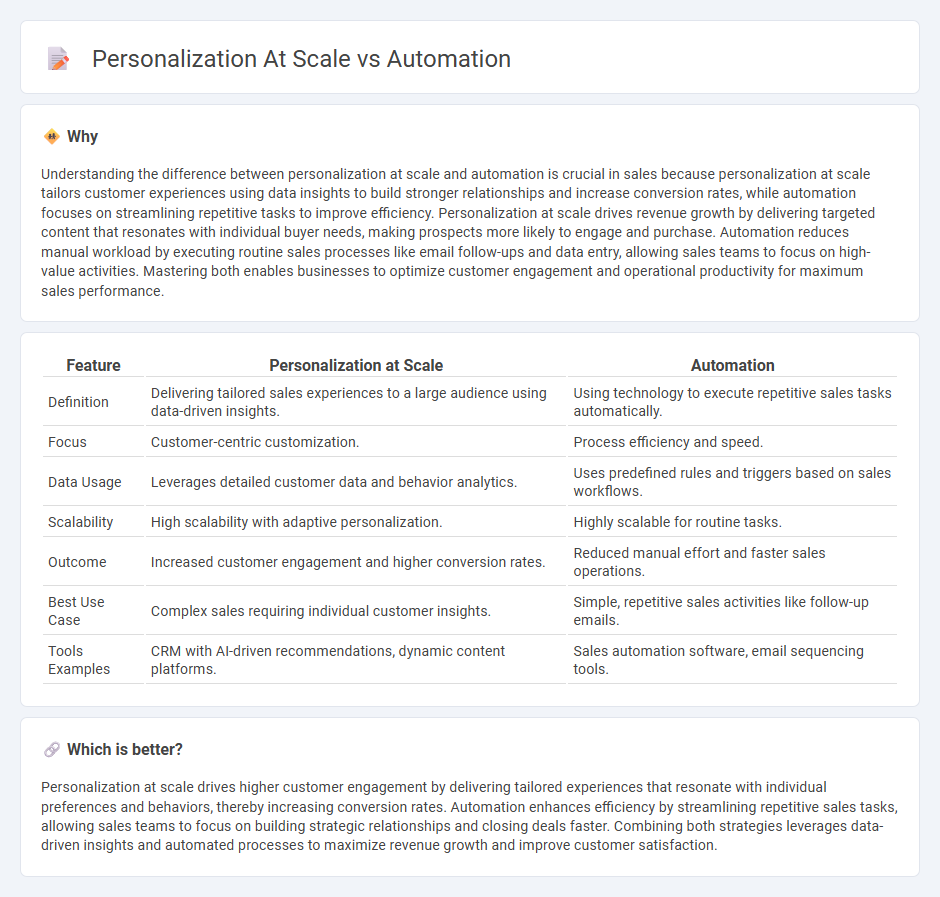
Personalization at scale leverages customer data to deliver tailored experiences that enhance engagement and boost conversion rates, while automation streamlines repetitive sales tasks to increase efficiency and reduce human error. Integrating both strategies enables businesses to create dynamic, responsive sales processes that adapt to individual customer needs without sacrificing operational speed. Explore how combining personalization at scale with automation can transform your sales performance.
Why it is important
Understanding the difference between personalization at scale and automation is crucial in sales because personalization at scale tailors customer experiences using data insights to build stronger relationships and increase conversion rates, while automation focuses on streamlining repetitive tasks to improve efficiency. Personalization at scale drives revenue growth by delivering targeted content that resonates with individual buyer needs, making prospects more likely to engage and purchase. Automation reduces manual workload by executing routine sales processes like email follow-ups and data entry, allowing sales teams to focus on high-value activities. Mastering both enables businesses to optimize customer engagement and operational productivity for maximum sales performance.
Comparison Table
| Feature | Personalization at Scale | Automation |
|---|---|---|
| Definition | Delivering tailored sales experiences to a large audience using data-driven insights. | Using technology to execute repetitive sales tasks automatically. |
| Focus | Customer-centric customization. | Process efficiency and speed. |
| Data Usage | Leverages detailed customer data and behavior analytics. | Uses predefined rules and triggers based on sales workflows. |
| Scalability | High scalability with adaptive personalization. | Highly scalable for routine tasks. |
| Outcome | Increased customer engagement and higher conversion rates. | Reduced manual effort and faster sales operations. |
| Best Use Case | Complex sales requiring individual customer insights. | Simple, repetitive sales activities like follow-up emails. |
| Tools Examples | CRM with AI-driven recommendations, dynamic content platforms. | Sales automation software, email sequencing tools. |
Which is better?
Personalization at scale drives higher customer engagement by delivering tailored experiences that resonate with individual preferences and behaviors, thereby increasing conversion rates. Automation enhances efficiency by streamlining repetitive sales tasks, allowing sales teams to focus on building strategic relationships and closing deals faster. Combining both strategies leverages data-driven insights and automated processes to maximize revenue growth and improve customer satisfaction.
Connection
Personalization at scale in sales leverages automation tools to analyze customer data and deliver tailored experiences efficiently to vast audiences. Automated systems streamline repetitive tasks such as lead scoring, email segmentation, and follow-ups while ensuring messages resonate with individual buyer preferences. Integrating AI-driven analytics enhances real-time decision-making and customer engagement, driving higher conversion rates and revenue growth.
Key Terms
Customer Segmentation
Customer segmentation enables brands to automate marketing efforts by grouping consumers based on behavior, demographics, and preferences, enhancing efficiency. Personalization at scale leverages this segmentation data to deliver tailored content, increasing customer engagement and conversion rates. Discover how integrating automation with precise segmentation transforms customer experiences and drives business growth.
Workflow Integration
Automation and personalization at scale require seamless workflow integration to maximize efficiency and customer engagement. Effective integration enables automated systems to deliver personalized content based on real-time data, ensuring consistency across multiple channels. Discover how advanced workflow solutions can transform your customer experience strategy.
Dynamic Content
Dynamic content leverages automation to deliver highly personalized experiences by adapting messaging and visuals in real-time based on user data and behavior, enabling scalable customization at unprecedented levels. Automation frameworks integrate AI-driven algorithms with customer insights to optimize engagement and conversion rates efficiently. Explore how aligning automation with personalization transforms dynamic content strategies for impactful digital marketing.
Source and External Links
Automation - Wikipedia - Automation refers to a wide range of technologies that minimize human intervention in processes by predetermining decision criteria and embodying those in machines, leading to labor savings, improved quality, and reduced costs.
What Is Automation? - IBM - Automation is the use of technology, programs, robotics, or processes to achieve outcomes with minimal human input, improving productivity and efficiency across business and industrial applications.
Understanding automation - Red Hat - Automation involves using technology to perform tasks with reduced human assistance, ranging from simple routine activities to complex operations in IT, business, and industry.
 dowidth.com
dowidth.com